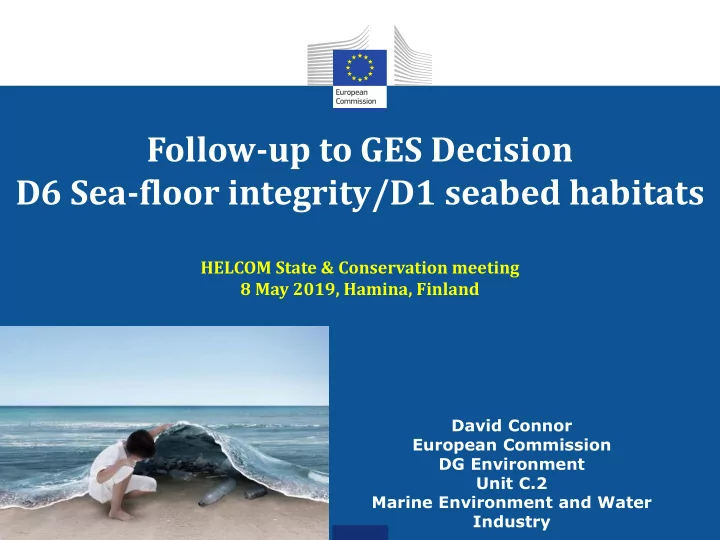

Follow-up to GES Decision D6 Sea-floor integrity/D1 seabed habitats HELCOM State & Conservation meeting 8 May 2019, Hamina, Finland David Connor European Commission DG Environment Unit C.2 Marine Environment and Water Industry
Decision follow-up work Progress in CIS 10-11.2018 WG GES and MSCG • ToRs finalised and adopted (GES_20-2018-06, MSCG_23-2018-02) • Maintain ICES for technical advice 12.2018 COM call for participants & co-chair • Nominations received from: 17 Member States: BE, DE, DK, EE, EL, ES, FI, FR, HR, IE, IT, LV, NL, PT, RO, SE, UK 2 IGOs: HELCOM, ICES 2 NGOs: NAVI, Seas at Risk 2019 meetings of TG Seabed: • 12-13 June 2019, Brussels • 27-28 November, Brussels (tbc)
TG Seabed ToRs • Main aims: • To develop a common framework for assessing the environmental status of seabed habitats • To propose threshold values for adverse effects on the state of a habitat (D6C5), maximum allowable extent of habitat loss (D6C4) and of habitat adversely affected (D6C5), and method for assessing overall status of a habitat, using criteria D6C4 and D6C5 • To ensure, as far as possible, that the methodological standards, data requirements and assessments under the MSFD are compatible with HD, WFD and CFP • To consider current pressures and activities to inform the feasibility of achieving such values • To identify where data and scientific knowledge are currently insufficient, and reflect such uncertainties in proposals made.
TG Seabed tasks/timelines Tasks Date Common framework for assessment of seabed habitats, 2019 and dealing with (sub)regional specificities Review of relevant methods under WFD, Habitats Directive, 2019 ICES, RSCs, national approaches and projects Methods for assessing criterion D6C2 (physical 2020 disturbance) Methods for assessing criteria D6C1 and D6C4 (physical 2020 loss) Principles for determining adverse effects on seabed 2020 habitats Methods for assessing adverse effects, using point source 2020 and spatial data/models (D6C5) Proposals for threshold values for adverse effects on habitat condition (D6C5) and maximum allowable extent of 2021 loss (D6C4) and adverse effect (D6C5) values Rules for integration of criteria D6C4 and D6C5 in order to 2021 define the status of a habitat
D6C2 Physical disturbance D6C2 Physical disturbance 1. Advise on methods to assess extent and distribution of physical disturbance pressures on seabed (all relevant activities) in MSFD marine waters 2. Demonstrate application of the advice by providing estimates of the spatial extent of physical disturbance per subdivision and per MSFD broad habitat type, with maps 3. Advise on key needs for improvement in data and methods 1. ICES technical advice -> TG Seabed -> WG GES 2. Delivery due Q4 2019
D6C2 Physical disturbance WKBEDPRES1, ICES, 24-26 Oct. 2018 24 participants from 10 countries, including DG ENV, EEA, HELCOM, OSPAR, various EU-funded projects, ICES Data Centre, ICES Working Groups Scope: 1. to identify physical disturbance pressure layers across four EU regions, including data flows and criteria for practical use to assess benthic impact 2. to collate benthic physical disturbance pressure layer data (Oct 2018-Aug 2019) 3. to evaluate and test operationally the application of compiled benthic physical disturbance pressure layers (WKBEDPRES2, 30 Sep -2 Oct 2019). Report: WKBEDPRES1
D6C2 Physical disturbance WKBEDPRES1 • Main outcomes: • Reviewed main activities causing disturbance and loss per region – > similar in all 4 EU regions • Fishing is most extensive cause of physical abrasion, with aggregate extraction and dredging also of relevance in most regions but much less extensive • Considered ‘smothering’ as well as ‘abrasion’ • Identified data sources for main activities • Identified methods for processing/assessment of data (compatible with VMS data methods) • Clarified needs of 2017 Decision (MSFD broad habitat types, ‘subdivision’ scales of assessment) • Defined requirements for further work (e.g. WG SFD, WG EXT, and WKBEDPRES2 in Q3 2019)
D6C1/C4 Physical loss D6C1/D6C4 Physical loss/per habitat 1. Advise on methods to assess extent and distribution of physical loss pressures on seabed in MSFD marine waters 2. Demonstrate application of the advice by providing estimates of the spatial extent of physical loss per subdivision and per MSFD broad habitat type, with maps 3. Advise on key needs for improvement in data and methods 1. ICES technical advice -> TG Seabed -> WG GES 2. Delivery due Q4 2019
D6C1/C4 Physical loss WKBEDLOSS, ICES, 11-13 Mar. 2019 20 participants from 9 countries, including DG ENV, HELCOM, various EU-funded projects, ICES WG FBIT, WKBEDPRES1 Scope: 1. to identify physical loss pressure layers across four EU regions, including data flows and criteria for practical use to assess benthic impact 2. to collate benthic physical loss pressure layer data (Oct 2018-Aug 2019) 3. to evaluate and test operationally the application of compiled benthic physical loss pressure layers (WKBEDPRES2, 30 Sep -2 Oct 2019). Report: WKBEDLOSS
D6C1/C4 Physical loss WKBEDLOSS • Main outcomes: • Definitions of disturbance and loss, based on operational use of data • Loss: sealing, non-sealing, biogenic habitat • Reviewed main activities (MSFD Annex III) causing loss per region – > similar in all 4 EU regions • Clarified needs of 2017 Decision (MSFD broad habitat types and EUNIS level 2, ‘subdivision’ scales of assessment) • Defined data flows for main activities in preparation for WKBEDPRES2 in Q3 2019
Recommend
More recommend